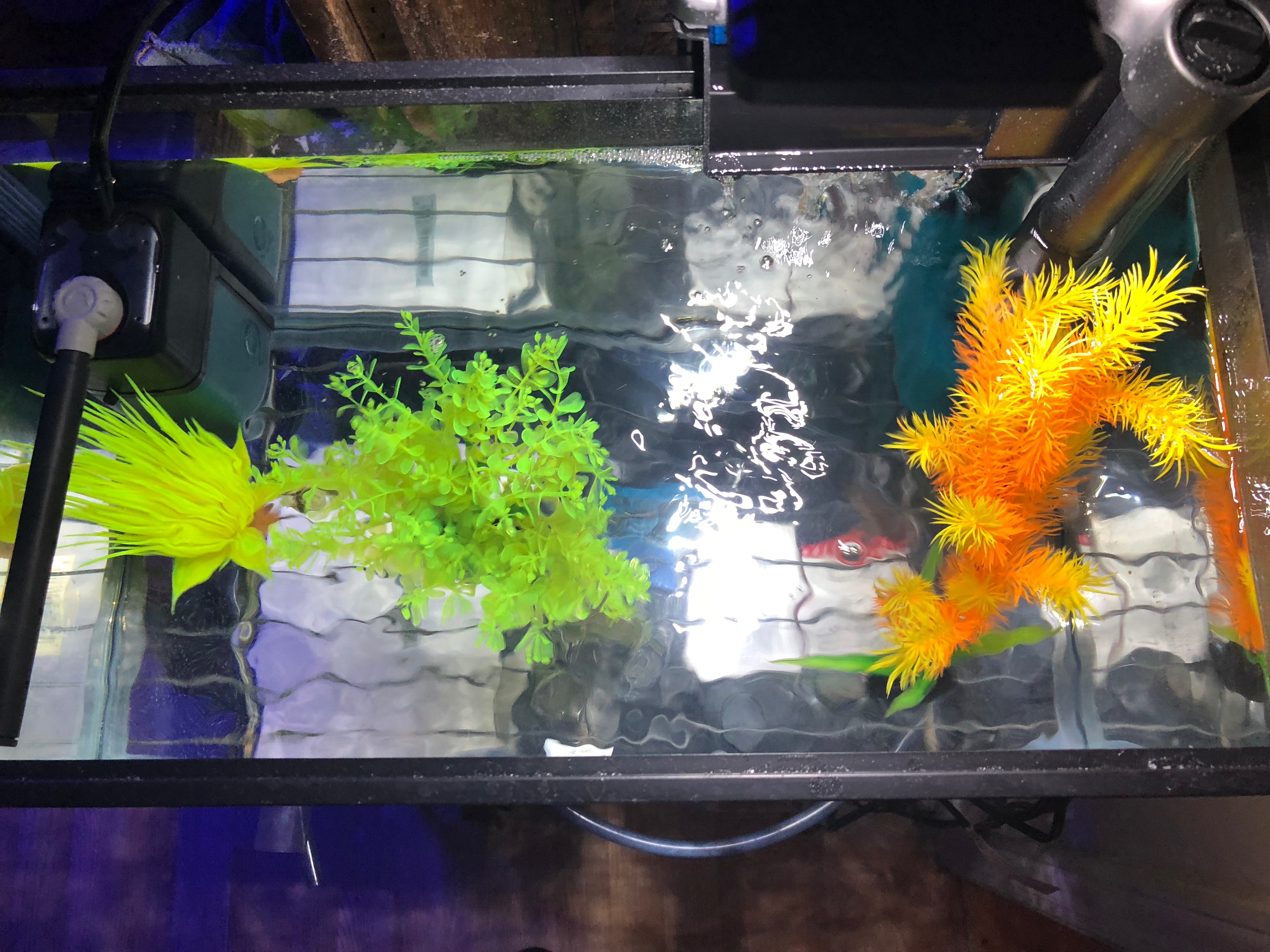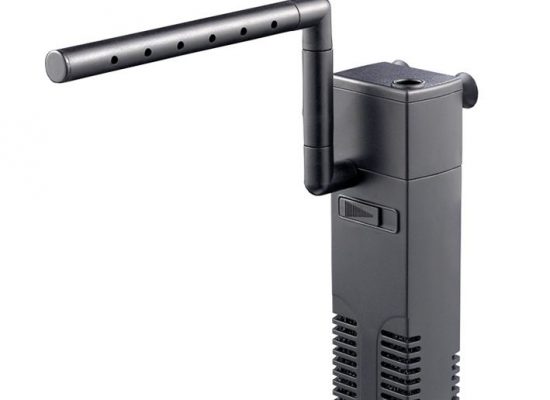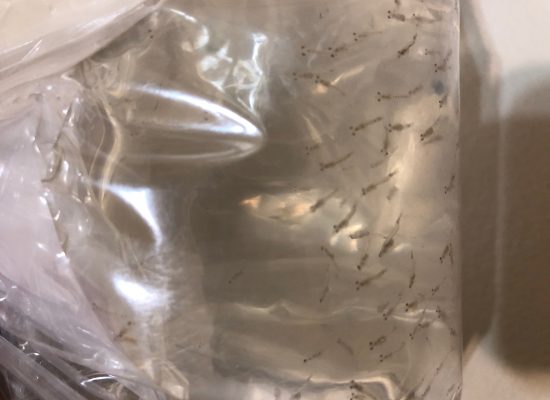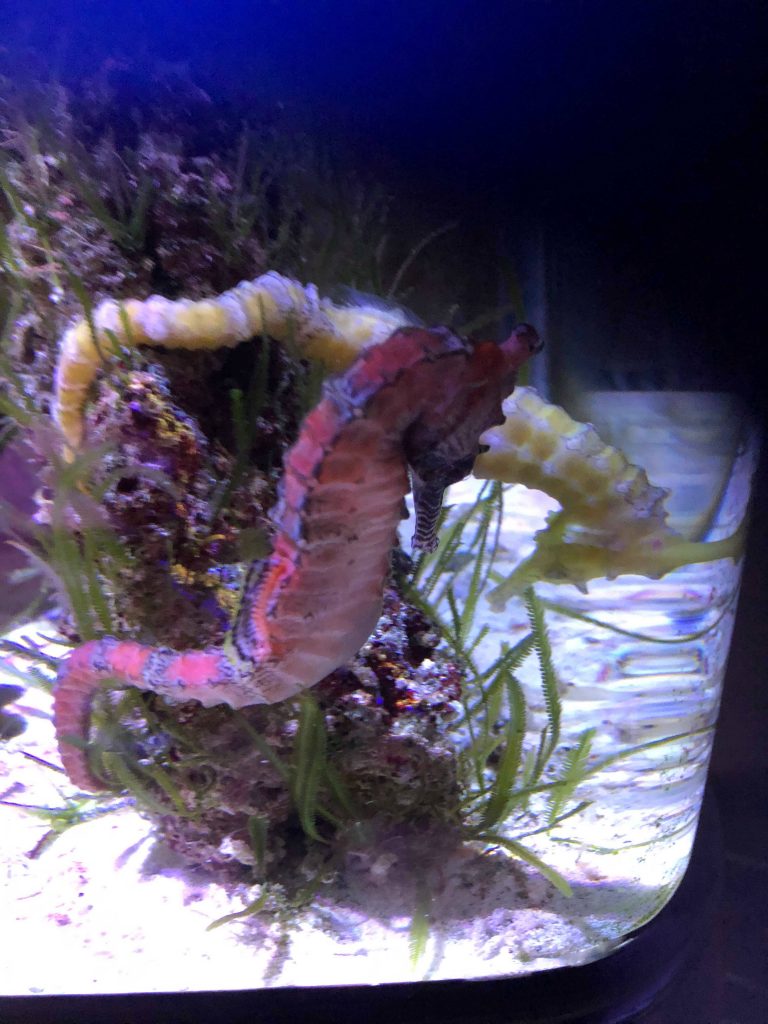- Joined
- Nov 18, 2015
- Messages
- 73
- Reaction score
- 115
Original post: https://seahorsewhisperer.com/how-to-get-new-seahorses-eating/
After taking so much time to research, plan and finally set up your first seahorse tank, “D” day finally arrives! In this case, I’m referring to DELIVERY day! The seahorses are finally here! Yay! But, after acclimating the seahorses based on the seller’s instructions, the seahorses won’t even look at food. Now what?
Well, first it’s important to remember that even captive bred seahorses have been through a great deal of stress in shipping, or even just transportation from a store to their new home. If someone blindfolded and transported you to a new location (even if it was a great new place), would you trust their offer of food right away? I know I wouldn’t! Often, the seahorses merely need a little time to adjust, and using the following tips can help get them eating quickly.
IF YOU WOULD PREFER TO WATCH THE VIDEO, JUST PRESS PLAY BELOW!
TIP #1 – GET THEM COMFY QUICKLY
I mentioned acclimating properly already, and you can read more about this in my ACCLIMATIONarticle. In addition to following the breeder or seller’s instructions and getting the seahorses into the tank with as little stress possible, it’s also important that the tank is set up properly. I’ve written a much longer article detailing steps to setting up a seahorse tank, but in regards to instant comfort, the following two points are key:

Provide multiple hitching options
TIP #2 – TRY FEEDING ON THE FIRST DAY!
The goal is to get the seahorse eating as soon as possible. So, I personally try feeding for the first time right away. I might lower the lighting during the temperature acclimation, but once the seahorses are in the tank, I want them to get accustomed to the true environment they will live in. I have loud children, and my seahorses literally line up at the glass when “Wine Wednesday” begins, because they are used to commotion and loud noise outside the tank. If the seahorses do not eat during that first feeding, I merely remove the food and try again later. However, more times than not, the seahorses hunger will be stronger than their fear. If they do happen to snick a piece of food, it will help them settle in and get comfortable even faster!
TIP #3 – ADJUST THE FLOW
Seahorses already have to settle for frozen foods instead of chasing down and ambushing delectable live crustaceans. The least we can do is make the frozen mysis appear to move, giving them the feeling of still being mighty predators. New seahorses especially are not likely to eat food that is just lying in front of them. Food that sits on the substrate instantly begins to go “bad”, so you can bet that the breeder or seller kept the food moving! Literally, I’ve seen videos in which seahorses look at the food, and then look around like “what is this?”. Eventually, they will take food from your fingers if you prefer, but on the first day, they will be more likely to snick at a moving target that “might” be a live treat.
My quarantine tanks are typically smaller than my display tanks, so providing enough flow to properly move the food around was a challenge. The three ways I personally found to work best include:

I use these spray bar internal filters in almost every QT tank
TIP #4 – MOVE AWAY FROM THE TANK
From personal experience, I know how difficult it can be to walk away from your brand new seahorses. You want to watch them, make sure that nothing is wrong and begin the magical bond between seahorse and keeper! But….the seahorses are not used to seeing a big face staring at them through glass. By walking away from the tank for a while, the seahorses will concentrate on the food, instead of you. After 20 – 30 minutes, clean up any left over foods. Typically, you’ll find that at least some has been eaten. I have actually been spotted (by family) peeking around doors, literally hiding from the new seahorses, so that I could watch them eat without disturbing them. Don’t judge me, I love them!
TIP #5 – COVER THE SIDES AND BACK OF THE TANK
As mentioned in tip 2, I do not coddle my seahorses. However, I am a firm believer that every seahorse has a different personality and different needs. If your seahorses are not responding to the other tips, they might be bothered by distractions outside the tank so much that they cannot calm down. Covering the sides and back of the tank can eliminate at least the visual distractions, and possibly allow the seahorses to concentrate of their food instead of movements from beyond their living space.
TIP #6 TRY DIFFERENT SIZES OR BRANDS OF FROZEN MYSIS
My Hippocampus Kuda prefer smaller mysis and seem to be most happy eating the Hikari brand. My Hippocampus Reidi share that desire for smaller pieces of food and also prefer to only eat shrimp with the eyeballs still attached (no kidding, both species will inspect the foods and only eat if eyes stare back at them). My Hippocampus Barbouri prefer to eat one piece of food at a time, and get overwhelmed if there is too much food floating around. While my Hippocampus Erectus will eat anything I put near the tank, and will beg for pieces of my sandwich as I walk past the glass.
Each seahorse species eats differently, and even within the species seahorses might have preferences based on how they were raised. If your seahorses are picking at the food offered and only eating certain pieces, pay attention to those pieces. If you can offer them more of the brand and size of food they prefer, they will begin to eat with gusto. Another great idea is to ask the breeder or seller what they were feeding the seahorses. If anyone knows the habits and preferences of your new seahorses, it will be the person who raised or kept them prior!

TIP #7 – FEED QUALITY FOODS
You can read more about the importance of providing quality foods in my HOW TO FEED SEAHORSES article. Do not buy discolored, re-frozen or expired foods, and if you find some in the freezer….THROW THEM OUT! Most seahorses will somehow know that the food is bad, and this might just be why they won’t eat for you. If they do happen to take the risk out of hunger, spoiled foods can make them very sick. If you are questioning the quality of your frozen food, try buying a new package. If the seahorses then start eating like madmen, you’ll have found the problem!
I have personally had the best luck with Hikari and PE Mysis. The Hikari brand provides smaller shrimp for my pickier eaters, and the PE Mysis provides a power packed big boy for my larger, more ambitious seahorses. However, living in a small town limits my options. I have yet to receive a frozen shipment of food that is still frozen, so I often have to buy whatever is available at my local stores. After a lot of complaining, these local stores have started taking better care of their frozen foods (at least the packages no longer look OBVIOUSLY refrozen), and I am experimenting with other brands. An upcoming Wine Wednesday guest will discuss the nutrition of one of these other brands, and provide options for direct delivery. Don’t miss that episode!
TIP #8 – CULTURE OR BUY LIVE FOODS
As mentioned in tip 3, seahorses are ambush predators. They enjoy stalking, chasing and snicking up their prey. If your new seahorses are stubborn or stressed out and not eating frozen offerings, give live foods a try. The excitement of hunting and eating live foods will often overcome any resistance to eating. The reaction is comparable to me when the smell of lasagna fills the room. Whether I am sad, mad, depressed, scared, happy or dieting, nothing will stop me from finding and eating the lasagna!

Live Mysids from Sach’s
Personally, I buy live foods every time I order new seahorses. Even if my seahorses eat frozen without a complaint, I can enrich the live foods to provide a nutrition filled treat! First I check to see if the breeder or seller of the seahorses offers live foods, as these would be specifically what my new seahorses would have eaten well (and of course buying from the same place often means a savings on shipping). But, if they do not, I order some from the numerous live food vendors online. Here at the Seahorse Whisperer Society, we are actually doing experiments, reviews and plan to promote the companies offering the highest quality live foods. But, until we can release the information, I have listed multiple live food vendors in the comments of the Youtube video. We are also finishing up the Cheryl Taylor interviews, which will detail ways to clean live foods before feeding.
I sure do wish there were more time in a day.
Weaning seahorses from live to frozen foods is not as difficult as it used to be, and SWS admin Lucie is working on a video to share her secret weaning process. Captive bred seahorses were raised eating both frozen and live foods. So while they will always instinctual prefer live, feeding both will not cause them to stop eating frozen. Culturing or buying live foods when expecting new seahorses is always a good idea, just in case they are needed and to use to provide additional nutrition.
TIP #9 – FOLLOW THE LEADER

Photo credit Sam Banfield
Breeders often use this tip to wean seahorse fry from live foods on to frozen. When dealing with a stubborn batch of fry that will not take frozen, adding an older seahorse to the tank will often make all the difference. Seahorses are curious creatures who tend to like to “follow the leader”. If an added older seahorse begins to eat frozen foods in front of the fry, they all follow his or her lead.
The same is true for older seahorses. If you already own seahorses, but have purchased a new pair that isn’t eating, adding one of your other seahorses might just do the trick. However, I must add that there is risk involved with mixing your current seahorses with new. The new seahorses are added to a quarantine tank in order to observe any problems they might have. If they did indeed have any issues, the added seahorse would be exposed to the same problems. To be safe, just keep the added seahorse in the new seahorse tank for the duration of quarantine. This ensures that all seahorses are pathogen free after the quarantine period and helps you avoid cross-contamination.
TIP #10 – DON’T FREAK OUT!
My family will tell you that I am the worst at assuming things are wrong with my seahorses. However, more times than not, I just do not understand their behaviors yet. When new seahorses do not eat right away, there are endless reasons for the refusal and multiple ways to determine if indicates a deeper problem. We are working on a video and article detailing the things to look for in new seahorses that might indicate a real issue. Until these are finished, please ask at any time if you’d like our opinion. You can scan our messenger app below to reach us at any time or post your pictures, videos and questions in the member forum.

Unfortunately, I often see an online request for help end badly, because social media allows anyone to provide answers. In many cases, a new seahorses is thrown into medication, when they just needed better water quality or a different sized food. There’s nothing wrong with turning to the online community for help if you are not sure whether your new seahorses are okay. But try not to jump into action before really determining the true problem. Be wary of anyone giving advice without asking more about your specific seahorses, set up and situation.
The best person to contact about a possible problem with your seahorses is the breeder or vendor who sold them. They not only WANT to help, but have the right to try and correct any issues with the seahorses they sold.
HOW LONG CAN SEAHORSES GO WITHOUT FOOD?
I do hope that these tips have helped you get your new seahorses eating. If not, I will just mention again that it is not quite time to freak out yet. Contact your supplier or breeder and ask them for help, or ask in our forum or question sections. For the record, a seahorse’s health does depend greatly on eating well. But, they will not die from a day or two without food. In fact, I have personally been scared to death when I had a seahorse not eat for 6 days during treatment for tail bubble. Instead of freaking out, I listened to the breeder and continued treatment. The seahorse not only made a full recovery, but I still have him today (3 years later).
Captive breeding has provided us with seahorses born and raised in the aquarium environment. These seahorses are not difficult to keep and rarely have the problems of a wild caught seahorse. If your new seahorses are refusing food, there is very likely a simple reason and solution. Talking with a breeder or experienced keeper can help you quickly figure out what might be causing the issue. Stay calm and think before reacting. Let me know your tips and tricks for feeding new seahorses. If these tips helped, we want to hear about that too!
After taking so much time to research, plan and finally set up your first seahorse tank, “D” day finally arrives! In this case, I’m referring to DELIVERY day! The seahorses are finally here! Yay! But, after acclimating the seahorses based on the seller’s instructions, the seahorses won’t even look at food. Now what?
Well, first it’s important to remember that even captive bred seahorses have been through a great deal of stress in shipping, or even just transportation from a store to their new home. If someone blindfolded and transported you to a new location (even if it was a great new place), would you trust their offer of food right away? I know I wouldn’t! Often, the seahorses merely need a little time to adjust, and using the following tips can help get them eating quickly.
IF YOU WOULD PREFER TO WATCH THE VIDEO, JUST PRESS PLAY BELOW!
TIP #1 – GET THEM COMFY QUICKLY
I mentioned acclimating properly already, and you can read more about this in my ACCLIMATIONarticle. In addition to following the breeder or seller’s instructions and getting the seahorses into the tank with as little stress possible, it’s also important that the tank is set up properly. I’ve written a much longer article detailing steps to setting up a seahorse tank, but in regards to instant comfort, the following two points are key:

Provide multiple hitching options
- Make sure there are plenty of hitches. By “hitches”, I mean fake plants, branching rock, plastic chains, or anything else that the seahorses can wrap their tails around. Stressed out seahorses will feel much safer once they are securely hitched to solid objects. Seahorses have only small pectoral fins by their gills and a dorsal fin to guide their movements. So, they depend greatly on their tails to wrap tightly around something to keep from being carried off by waves or flow. Once hitched, the seahorses can begin to blend into their surroundings and begin to get comfortable in their new environment.
- Make sure they are not exposed to ammonia! Always follow the acclimation instructions of the seller, because they may have shipped the seahorses in a special way. But, most will tell you to temperature acclimate the seahorses (WITHOUT OPENING THE BAG), and then put the seahorses directly in the tank. The reason is to avoid the seahorse sitting in ammonia during a long drip acclimation period. To learn more, watch the AMMONIA POISONING video. It’s also important that you have tested the water in the tank, and never put seahorses in if the water has ammonia or nitrite.
TIP #2 – TRY FEEDING ON THE FIRST DAY!
The goal is to get the seahorse eating as soon as possible. So, I personally try feeding for the first time right away. I might lower the lighting during the temperature acclimation, but once the seahorses are in the tank, I want them to get accustomed to the true environment they will live in. I have loud children, and my seahorses literally line up at the glass when “Wine Wednesday” begins, because they are used to commotion and loud noise outside the tank. If the seahorses do not eat during that first feeding, I merely remove the food and try again later. However, more times than not, the seahorses hunger will be stronger than their fear. If they do happen to snick a piece of food, it will help them settle in and get comfortable even faster!
TIP #3 – ADJUST THE FLOW
Seahorses already have to settle for frozen foods instead of chasing down and ambushing delectable live crustaceans. The least we can do is make the frozen mysis appear to move, giving them the feeling of still being mighty predators. New seahorses especially are not likely to eat food that is just lying in front of them. Food that sits on the substrate instantly begins to go “bad”, so you can bet that the breeder or seller kept the food moving! Literally, I’ve seen videos in which seahorses look at the food, and then look around like “what is this?”. Eventually, they will take food from your fingers if you prefer, but on the first day, they will be more likely to snick at a moving target that “might” be a live treat.
My quarantine tanks are typically smaller than my display tanks, so providing enough flow to properly move the food around was a challenge. The three ways I personally found to work best include:
- Internal filters with spray bar attachments. These little filters are so great in a smaller tank! They shouldn’t be used as the main filtration for the tank, but they are perfect for providing flow and keeping food off the floor. The filters even come in multiple sizes, so they can be helpful in the smallest of tanks.
- Rigid airline hooked up to an adjustable air pump. These won’t work as well as the internal filter spray bars, but can provide a little extra movement if you do not have anything else.
- Air lift. Dan at Seahorse Source taught me how to make and use this nifty contraption! I bought all parts at Lowes, and only needed an airline and air pump to make it work. The basic idea is that the air being pushed through the airline into the bottom of the lift causes anything at the bottom of the tank to be sucked into the tubing, and then pushed up to be released from the top….back into the water. I’m pushing Dan to make a video showing this in more detail, but until then, just message for further details. These air lifts work wonderfully in fry tanks, and could be helpful in smaller quarantine tanks also.

I use these spray bar internal filters in almost every QT tank
TIP #4 – MOVE AWAY FROM THE TANK
From personal experience, I know how difficult it can be to walk away from your brand new seahorses. You want to watch them, make sure that nothing is wrong and begin the magical bond between seahorse and keeper! But….the seahorses are not used to seeing a big face staring at them through glass. By walking away from the tank for a while, the seahorses will concentrate on the food, instead of you. After 20 – 30 minutes, clean up any left over foods. Typically, you’ll find that at least some has been eaten. I have actually been spotted (by family) peeking around doors, literally hiding from the new seahorses, so that I could watch them eat without disturbing them. Don’t judge me, I love them!
TIP #5 – COVER THE SIDES AND BACK OF THE TANK
As mentioned in tip 2, I do not coddle my seahorses. However, I am a firm believer that every seahorse has a different personality and different needs. If your seahorses are not responding to the other tips, they might be bothered by distractions outside the tank so much that they cannot calm down. Covering the sides and back of the tank can eliminate at least the visual distractions, and possibly allow the seahorses to concentrate of their food instead of movements from beyond their living space.
TIP #6 TRY DIFFERENT SIZES OR BRANDS OF FROZEN MYSIS
My Hippocampus Kuda prefer smaller mysis and seem to be most happy eating the Hikari brand. My Hippocampus Reidi share that desire for smaller pieces of food and also prefer to only eat shrimp with the eyeballs still attached (no kidding, both species will inspect the foods and only eat if eyes stare back at them). My Hippocampus Barbouri prefer to eat one piece of food at a time, and get overwhelmed if there is too much food floating around. While my Hippocampus Erectus will eat anything I put near the tank, and will beg for pieces of my sandwich as I walk past the glass.
Each seahorse species eats differently, and even within the species seahorses might have preferences based on how they were raised. If your seahorses are picking at the food offered and only eating certain pieces, pay attention to those pieces. If you can offer them more of the brand and size of food they prefer, they will begin to eat with gusto. Another great idea is to ask the breeder or seller what they were feeding the seahorses. If anyone knows the habits and preferences of your new seahorses, it will be the person who raised or kept them prior!

TIP #7 – FEED QUALITY FOODS
You can read more about the importance of providing quality foods in my HOW TO FEED SEAHORSES article. Do not buy discolored, re-frozen or expired foods, and if you find some in the freezer….THROW THEM OUT! Most seahorses will somehow know that the food is bad, and this might just be why they won’t eat for you. If they do happen to take the risk out of hunger, spoiled foods can make them very sick. If you are questioning the quality of your frozen food, try buying a new package. If the seahorses then start eating like madmen, you’ll have found the problem!
I have personally had the best luck with Hikari and PE Mysis. The Hikari brand provides smaller shrimp for my pickier eaters, and the PE Mysis provides a power packed big boy for my larger, more ambitious seahorses. However, living in a small town limits my options. I have yet to receive a frozen shipment of food that is still frozen, so I often have to buy whatever is available at my local stores. After a lot of complaining, these local stores have started taking better care of their frozen foods (at least the packages no longer look OBVIOUSLY refrozen), and I am experimenting with other brands. An upcoming Wine Wednesday guest will discuss the nutrition of one of these other brands, and provide options for direct delivery. Don’t miss that episode!
TIP #8 – CULTURE OR BUY LIVE FOODS
As mentioned in tip 3, seahorses are ambush predators. They enjoy stalking, chasing and snicking up their prey. If your new seahorses are stubborn or stressed out and not eating frozen offerings, give live foods a try. The excitement of hunting and eating live foods will often overcome any resistance to eating. The reaction is comparable to me when the smell of lasagna fills the room. Whether I am sad, mad, depressed, scared, happy or dieting, nothing will stop me from finding and eating the lasagna!

Live Mysids from Sach’s
Personally, I buy live foods every time I order new seahorses. Even if my seahorses eat frozen without a complaint, I can enrich the live foods to provide a nutrition filled treat! First I check to see if the breeder or seller of the seahorses offers live foods, as these would be specifically what my new seahorses would have eaten well (and of course buying from the same place often means a savings on shipping). But, if they do not, I order some from the numerous live food vendors online. Here at the Seahorse Whisperer Society, we are actually doing experiments, reviews and plan to promote the companies offering the highest quality live foods. But, until we can release the information, I have listed multiple live food vendors in the comments of the Youtube video. We are also finishing up the Cheryl Taylor interviews, which will detail ways to clean live foods before feeding.
I sure do wish there were more time in a day.
Weaning seahorses from live to frozen foods is not as difficult as it used to be, and SWS admin Lucie is working on a video to share her secret weaning process. Captive bred seahorses were raised eating both frozen and live foods. So while they will always instinctual prefer live, feeding both will not cause them to stop eating frozen. Culturing or buying live foods when expecting new seahorses is always a good idea, just in case they are needed and to use to provide additional nutrition.
TIP #9 – FOLLOW THE LEADER

Photo credit Sam Banfield
Breeders often use this tip to wean seahorse fry from live foods on to frozen. When dealing with a stubborn batch of fry that will not take frozen, adding an older seahorse to the tank will often make all the difference. Seahorses are curious creatures who tend to like to “follow the leader”. If an added older seahorse begins to eat frozen foods in front of the fry, they all follow his or her lead.
The same is true for older seahorses. If you already own seahorses, but have purchased a new pair that isn’t eating, adding one of your other seahorses might just do the trick. However, I must add that there is risk involved with mixing your current seahorses with new. The new seahorses are added to a quarantine tank in order to observe any problems they might have. If they did indeed have any issues, the added seahorse would be exposed to the same problems. To be safe, just keep the added seahorse in the new seahorse tank for the duration of quarantine. This ensures that all seahorses are pathogen free after the quarantine period and helps you avoid cross-contamination.
TIP #10 – DON’T FREAK OUT!
My family will tell you that I am the worst at assuming things are wrong with my seahorses. However, more times than not, I just do not understand their behaviors yet. When new seahorses do not eat right away, there are endless reasons for the refusal and multiple ways to determine if indicates a deeper problem. We are working on a video and article detailing the things to look for in new seahorses that might indicate a real issue. Until these are finished, please ask at any time if you’d like our opinion. You can scan our messenger app below to reach us at any time or post your pictures, videos and questions in the member forum.

Unfortunately, I often see an online request for help end badly, because social media allows anyone to provide answers. In many cases, a new seahorses is thrown into medication, when they just needed better water quality or a different sized food. There’s nothing wrong with turning to the online community for help if you are not sure whether your new seahorses are okay. But try not to jump into action before really determining the true problem. Be wary of anyone giving advice without asking more about your specific seahorses, set up and situation.
The best person to contact about a possible problem with your seahorses is the breeder or vendor who sold them. They not only WANT to help, but have the right to try and correct any issues with the seahorses they sold.
HOW LONG CAN SEAHORSES GO WITHOUT FOOD?
I do hope that these tips have helped you get your new seahorses eating. If not, I will just mention again that it is not quite time to freak out yet. Contact your supplier or breeder and ask them for help, or ask in our forum or question sections. For the record, a seahorse’s health does depend greatly on eating well. But, they will not die from a day or two without food. In fact, I have personally been scared to death when I had a seahorse not eat for 6 days during treatment for tail bubble. Instead of freaking out, I listened to the breeder and continued treatment. The seahorse not only made a full recovery, but I still have him today (3 years later).
Captive breeding has provided us with seahorses born and raised in the aquarium environment. These seahorses are not difficult to keep and rarely have the problems of a wild caught seahorse. If your new seahorses are refusing food, there is very likely a simple reason and solution. Talking with a breeder or experienced keeper can help you quickly figure out what might be causing the issue. Stay calm and think before reacting. Let me know your tips and tricks for feeding new seahorses. If these tips helped, we want to hear about that too!















